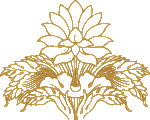The Ten Pillars
"Shäd-gyüd Deg-pa'i Ka-chen-chu"
“The ten great pillars who supported the explanation lineages"
Ten Tibetans are especially singled out for their foundational role in the transmission of Buddhism in Tibet. They were particularly important in ensuring the continuity of the explanations of dharma in Tibet.
1. Thönmi Sambhota
Thönmi Sambhota was born in Thon district in the area of Yorwo Lunggu in Tibet in approximately 619 AD and demonstrated outstanding intelligence from a very young age. At the age of fifteen, he was sent to India by the Tibetan King Songtsen Gampo, where he studied for seven years. After returning from India, Thönmi Sambhota developed the Tibetan script, which was derived from the devanagri and other Indian scripts, and formulated the written Tibetan language, for the first time. He became one of the most important ministers of the King.
King Songtsen Gampo (617-650) prepared the way for transmission of the buddhist teachings. Regarded as an incarnation of Avalokiteshvara he married Bhrikuti, a Nepalese princess and Wen Cheng a Chinese princess of China, each of whom brought a sacred statue of Buddha Shakyamuni to Lhasa.
Thönmi Sambhota played an important role in arranging for these Buddha statues to be brought to Tibet. Songtsen Gampo built the first Buddhist temples in Tibet and established a code of laws based on buddhist principles. During his reign the translation of Buddhist texts into Tibetan began.
2. Vairochana
The great Tibetan Translator Vairochana was born in the Nyemo area of central Tibet during the time of King Trisong Detsen. He was one of the first seven Tibetan monks. Padmasambhava recognized his outstanding qualities and potentials, and he was sent to India to study with Shri Simha. He is also one of the three main masters to bring the Dzogchen teachings to Tibet.
3. Kawa Paltsek
Kawa Paltsek was a direct student of both Padmasambhava and Shantarakshita. He was one of the most important contributors to the translation of the Tibetan Tripitaka and the Nyingma Gyübum. He was born in the Phenpo Valley and became an eminent translator in accordance with a prophecy by Padmasambhava. He was one of the first seven monks ordained by Shantarakshita. He received Vajrayana teachings from the great master Padmasambhava and attained unimpeded clairvoyance. "Kawa" is a place name and "Paltsek" means "Mountain of resplendence."
4. Chokro Luyi Gyaltsen
Chokro Luyi Gyaltsen was an early Tibetan translator of great importance and one of the twenty-five disciples of Padmasambhava. He worked very closely with the great Indian masters Vimalamitra, Jnanagarbha, Jinamitra, and Surendrabodhi. He is very important to the continuation of the Vinaya lineage (monastic lineage) in Tibet. After attaining realization at Chuwori in central Tibet, he aided Padmasambhava in transcribing and concealing terma treasures. The great tertön Karma Lingpa (14th century) is regarded as a reincarnation of this great master.
5. Yeshe De
Yeshe De was a great Tibetan translator and disciple of Padmasambhava. He participated in the translation of more than 200 texts into Tibetan and was one of the greatest translators of Tibet. He was also known as Nanam Yeshe De or Zhang Yeshe De.
6. Lochen Rinchen Sangpo [957-1055]
Lochen Rinchen Sangpo was the first translator of the New Translation School or New Mantra School period, which began in the late 9th and early 10th century. Translations from the 7th through the 9th centuries, up to and including King Triral, are called the "Old School of Early Translations" (snga 'gyur rnying ma), and later ones are known as the "New Schools of Later Translations" (phyi 'gyur gsar ma). The New Schools are Kagyu, Sakya, and Gelug; the Old School refers to Nyingma.
Sangpo was born in Ngari region of western Tibet in 957 C.E. He was ordained at the age of thirteen by the Abbot Yeshe Zangpo. The King of Ngari sent him to Kashmir and India to study buddhism, where he studied with over seventy five -panditas- and became well-versed in the sutras and tantras. He invited many Indian panditas to Tibet and is one of the great Tibetan translators who contributed to the translation of the Kangyur and Tenjyur into Tibetan. It is said that his translations consist of about 17 volumes of the Kangyur, 33 volumes in Tenjyur, and over 100 volumes of tantras. He edited the earlier translations as well. He passed away in 1055.
7. Dromtön Gyalwe Jungney [1005-1064]
Dromtönpa was a heart son of the great Indian master, Atisha, and the founder of 'Reting Monastery' in central Tibet. He was born in western Tibet in 1005 and was named Chöphel. At an early age, he studied with Geshe Yung Chögon and later received the upasaka vow from Nanam Wangchuk Dorje, who conferred on him the name, Gyalwe Jungney. He studied the Madhyamaka philosophy, tantras, and other teachings from Khenpo Setsun. He studied Sanskrit with the great Indian master, Smritijnana. At the age of thirty, he met Atisha in Western Tibet and became his student. At the age of fifty-four, he founded Reting Monastery. He built the stupa for the relics of Atisha when he passed away, and the students of Atisha continued to study and practice under Dromtönpa. He became the main lineage holder of the Kadampa tradition of the Atisha. He composed many texts and passed away in 1064.
8. Ngok Lotsawa Loden Sherab [1059-1109]
Ngok Lotsawa Loden Sherab was born in 1059. At the age of seventeen, he studied with his uncle Ngok Lekpe Sherap. After a year, he began to travel to India with Tsen Khawoche and others to study with great Indian masters. He studied with many Indian panditas for seventeen years and then returned to Tibet in 1092 C.E. and became one of the most important Tibetan translators. He translated the pramana (logic/valid cognition) literature and abhisamaya-alamkara (ornament to clear realization) literature and made a great contribution to the buddhism of Tibet. He taught extensively and became the second seat holder of the Sangphu Neuthok monastery, which was founded in 1071 C.E. by the Ngok Lekpe Sherap, who was the first seat-holder of Sangphu Neuthok Monastery. Ngok Loden Sherap passed away at the age of fifty-five, in 1109.
9. Sakya Pandita Kunga Gyaltsen [1182-1251]
Sakya Pandita was one of the five forefathers of Sakya and the grandson of Kunga Nyingpo. He became a student of Drakpa Gyaltsen, who was his uncle, and began studying logic, languages, astrology, medicine, and many topics of buddha dharma. He mastered all the subjects he studied and became one of the most well-known thirteenth-century Tibetan masters and scholars. At the age of twenty-three, he received the full monastic ordination from Panchen Shakya Shri Bhadra. At the age of twenty-five, he became the throne-holder of the Sakya and taught dharma for many years. He later became teacher of the Mongolian emperor and exercised political power on behalf of the Mongols.
10. Gö-Khukpa Lheytse [early 11th century]
Gö-Khukpa Lheytse was born in the Tsang Tana region of central Tibet and was a contemporary of Marpa Lotsawa. He first studied in Tibet and then travelled to Kashmir, India, and Nepal. He studied with seventy-two Panditas of India and mastered the Sanskrit language and Buddhist teachings. He translated many scriptures into Tibetan and contributed to the translation effort of the Kangyur and Tenjyur. He is one of the most important translators in the New Translation School, after Lochen Rinchen Sangpo.





